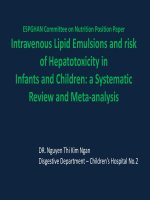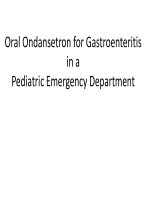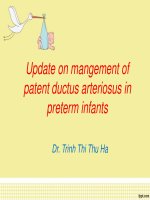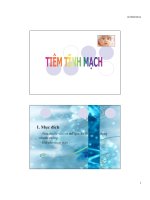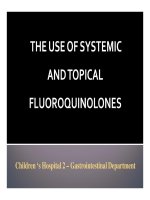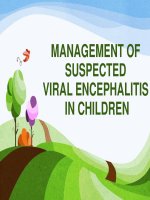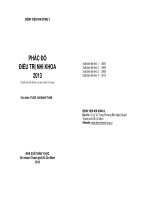Neonatal Hypoxic – Ischemic Encephalopathy | Website Bệnh viện nhi đồng 2 - www.benhviennhi.org.vn
Bạn đang xem bản rút gọn của tài liệu. Xem và tải ngay bản đầy đủ của tài liệu tại đây (1.31 MB, 28 trang )
Neonatal
Hypoxic – Ischemic
Encephalopathy
Treatment Approaches from Evidence
Dr. Nguyen Pham Minh Tri – NICU – Children’s Hospital 2
Content
1.
2.
3.
4.
Introduction
HIE and Hypothermia
Other combination treatments
Conclusion
HIE in the world
Major public health issue
23% of the total 4 M deaths in the world
20% of global incidence of cerebral palsy
Lawn JE et al, Lancet 2005
Etiologies of HIE
Maternal
Cardiac arrest
Asphyxiation
Severe anaphylaxis
Status epilepticus
Hypovolemic shock
Uteroplacental
Placental abruption
Cord prolapse
Uterine rupture
Hyperstimulation with
oxytocic agents
Fetal
Fetomaternal
haemorrhage
Twin to twin transfusion
Severe iso-immune
haemolytic disease
Cardiac arrhythmia
HIE severity and
morbidity/mortality
Moderately severe
1-3 / 1000 livebirths
Severe
0.5-2 / 1000 livebirths
Neonatal mortality: 50-75%
Severe handicaps: 30-50%
Severe handicaps: 80%
(epilepsy, cognitive impairment,
CP…)
Mild handicaps: 10-20%
Mild handicaps: 10-20%
Normal outcome at 2y: 30-40% Normal outcome at 2y: 10%
Early evaluation of HIE
• Early, repeated clinical examination: Sarnat staging+++
• Clinical investigations:
– EEG: early, continuous recording / standard EEG or
aEEG
– Ultrasonography: easy but non specific, as early as
possible
Short term prognosis. HYPOTHERMIA?
– MRI: standard sequences + Diffusion +/- DTI +
MRSpectroscopy: btw day 3 - day 8 +/- day 10-15
Long term outcome.
Sarnat grading scale for HIE
Amplitude EEG features in HIE
HIE and MRI features
Rutherforf et al., Lancet 2010
Figure 1: Mechanisms of evolving neural injury in HIE
HIE and energy failures
• First energy failure during
HIE
• Rapid recovery
• Secondary energy failure
after 6-12h post HIE
• Mitochondrial insult
• Cell death and apoptosis
The ratio of inorganic phosphate (Pi) to phosphocreatine (PCr) is validated marker
of mitochondrial function.
Brain metabolism is normal following
resuscitation but deteriorates later
Azzopardi et al. Pediatr Res 1989;25:445-451
Hypothermia: concept
•
•
•
•
•
To induce a stable central temperature around 33.5 +/- 0.5°C
Before 6 hours of life
In the most stable manner
For a 72h duration
Progressive and cautious rewarming 0.2°C / h
Hypothermia: cellular effects
cerebral metabolism edema
energy utilization
cytotoxic amino acid accumulation
(glutamate) and nitric oxide
platelet-activating factor inflammatory
cascade
secondary neuronal damage and cell death
extent of brain damage
blood brain barrier dysruption
Experimental evidence supporting
therapeutic hypothermia
• Hypothermia applied after HIE:
– Reduces elevation of dopamine, free fatty acid and
glutamate
• Stroke 1989 ;20:904-10.
– Preserves cerebral energy metabolism
• Pediatr Res 1995 ;37:667-670; Pediatr Res 1997 ;41:803-808
– Reduces the delayed increase in extracellular glutamate
• Neuroreport 1997 ;8:3359-62
– Reduces the secondary rise in cortical impedance
(cytotoxic oedema)
• Pediatrics 1998 ;102:1098-1106
– Inhibits apoptotic cell death
• Neuropathol Appl Neurobiol 1997 ;23:16-25
Hypothermia
Head cooling or
total body cooling
Hypothermia criteria
Beneficial effect of hypothermia
according to HIE severity
Tagin et al., Cochrane 2012
NNT 6-8
Beneficial effect of hypothermia
according to coolling technique
Tagin et al., Cochrane 2012
Normal outcome following
hypothermia for HIE
Tagin et al., Cochrane 2012
Impact of hypothermia on MRI findings
THERAPEUTIC
HYPOTHERMIA
reduces basal
ganglia and WM
lesions
BUT
has NO effect on
cortical damage
Rutherford et al., 2009
Mid- long-term outcomes:
neurocognitive/behavior scales
• 12-30 months: Bayley
– (Eicher & al., 2004; Jacobs & al., 2011;
Shankaran & al., 2005)
• 6-7 years: WPPSI-III / WISC-IV / NEPSY /
M-ABC
– (Marlow & al., 2005; Shankaran & al., 2012)
• 9-10 years: WISC-III / M-ABC / CBCL
– (de Veries & Jongmans, 2010)
Childhood outcomes after
hypothermia for HIE
• Objective
– Long term evaluation (6-7 y) of infants having
experienced hypothermia for HIE
• Methods and patients
–
–
–
–
208 infants with HIE 2-3 at birth
93 controls (6y8m) vs 97 hypothermia ( 6y7m)
18 lost (15% of surviving)
Motor : GMFCS / Intellect : WPPSI-III & WISC-IV /
Attention, FE, Visuospatial: NEPSY / Emotional &
Social : Child Health Questionnaire
Shankaran et al., NEJM 2012
Childhood outcomes after
hypothermia for HIE
• Results
– Hypothermia ( n = 97)
•
•
•
•
•
27 deaths (28 %)
5 lost (5 %)
12/69 CP (17 %)
1/67 blindness (1 %)
3/63 deafness (5%)
– Controls (n = 93)
•
•
•
•
•
41 deaths (44 %)
13 lost (14 %)
15/52 CP (29 %)
2/50 blindness (4 %)
1/50 deafness (2%)
Shankaran et al., NEJM 2012
Childhood outcomes after
hypothermia for HIE
• Results
– Hypothermia
• 19/70 IQ < 70 (27 %)
• 2/48 dysexecutive functions (< 70) (4 %)
• 2/53 visuo-spatial impairment (< 70) (4 %)
– Controls
• 17/52 IQ < 70 (33 %)
• 4/32 dysexecutive functions (< 70) (13 %)
• 1/36 visuo-spatial impairment (< 70) (3 %)
Shankaran et al., NEJM 2012
